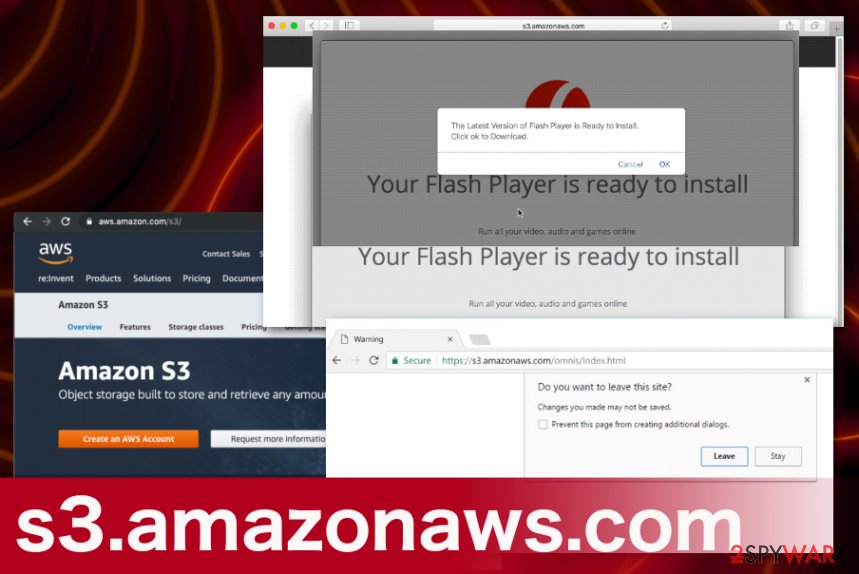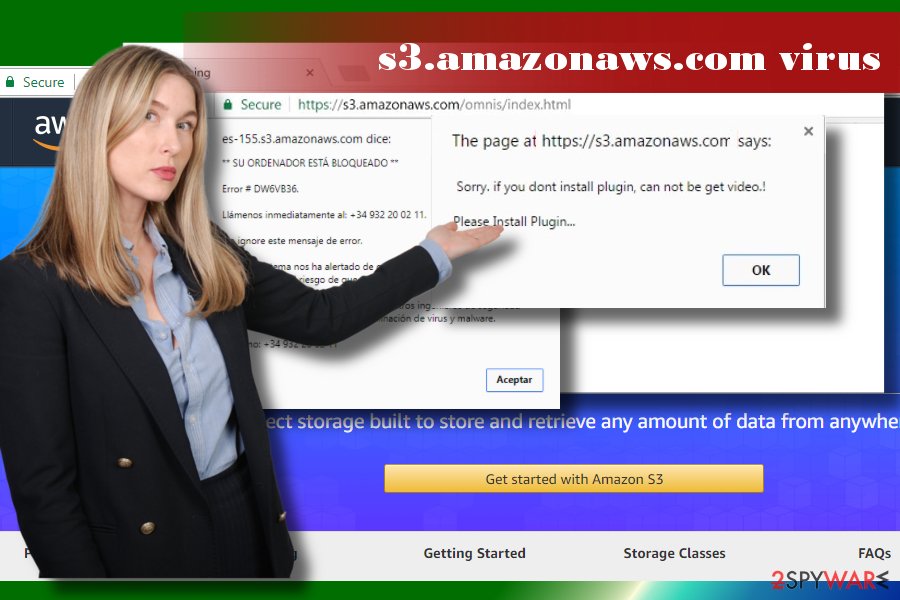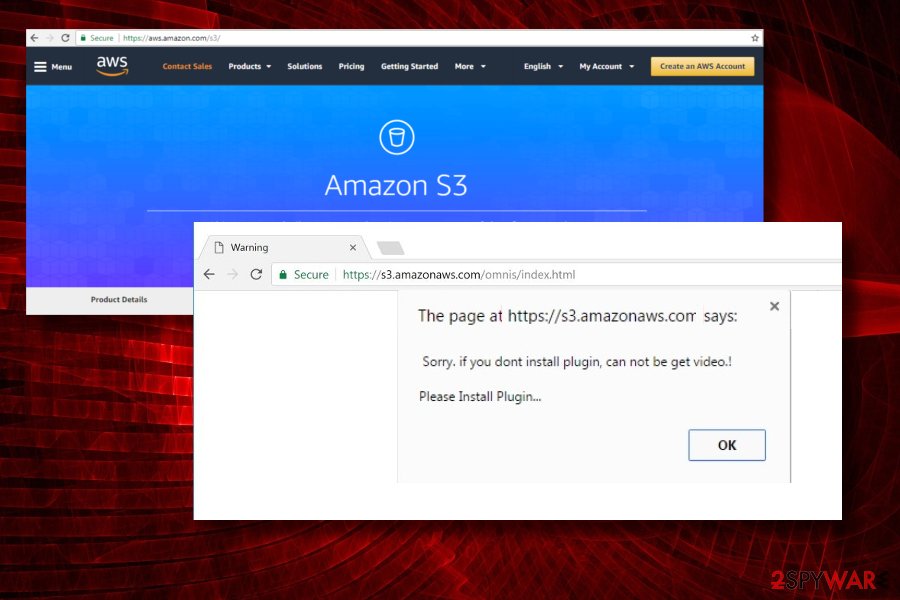s3.amazonaws.com is the website that shows pop-ups with false claims about outdated software to load malicious programs on the PC

s3.amazonaws.com is the promotional website that is associated with ad-supported sites so various issues regarding online traffic redirects and pop-ups can occur. S3.amazonaws.com is the site claiming about updates and needed installations with the purpose of tricking people into allowing potentially unwanted programs. The domain is hosted by Amazon AWS that is a legitimate service and intended to provide IT resources for users even though it gets misused by malicious actors with shady goals. Redirects and revenue generation is the main purpose of such adware-type intruders and pages that promote infections with alleged Flash Player or different Adobe product updates.
Users who encounter these intrusive redirects to s3.amazonaws.com can also get exposed to other advertisements, PUP distribution pages, and websites containing malicious scripts or even triggers malware infiltration. This page delivers pop-ups about the prepared installation, and users only need to click the OK button to download the said update. Unfortunately, the process is not related to Adobe or another software developer – the background process is leading to cyber infection, and audio or video software is nor installed nor updated during such process. By allowing the alleged update, you agree to install malicious content onto the system that can differ from potentially unwanted programs, in-browser intruders to really dangerous trojans, or malware.
| Name | S3.amazonaws.co |
|---|---|
| Type | Adware/ Scam |
| Tactics | Deliver update messages, encourage people to install the needed software and deliver PUPs this way |
| Symptoms | Promotional content shows up on the screen, and fake software updater manages to download malicious programs or infect the machine directly with harmful threats |
| Main danger | Scam delivers malware with various purposes and can lead to serious privacy and security issues |
| Distribution | Deceptive pages, pop-ups with advertisements, redirects to dubious online services, commercial material. Freeware installations can lead to PUP infiltrations that later on trigger such redirects to scammy sites |
| Elimination | Getting a proper anti-malware tool can make a huge difference in S3.amazonaws.co removal because AV tools can find various malicious files and delete them what improves the general performance of the machine |
| System repair option | There are many background processes this intruder may run on the machine once it gets infected, so you should additionally check your device with a PC repair or cleaner tool like Reimage Reimage Cleaner that may find and fix affected or even corrupted registry entries, system files |
S3.amazonaws.com is a misleading domain, which has been reported for hijacking web browser’s new tab URL and causing frequent web browsers redirects to Amazonaws related websites and malicious online services. It works as an advertising platform and may be used for promoting expensive items, useless services, or even malware.[1]
However, unexpected S3.amazonaws.com pop-ups should not be ignored. Original Amazon aws S3 or Amazon Web Service (AWS)[2] is not malicious. It’s a legitimate cloud storage web service that belongs to Amazon Inc.
Many people prefer using this service due to the multiplicity of functions and fair pricing. Nonetheless, cybersecurity experts warn that cybercriminals might misuse the S3.amazonaws services for malicious activities, such as scam or malware dissemination.
S3.amazonaws.com scam pop-ups state:
The Latest Version of Flash Player is Ready to Install.
Click ok to Download.
Your Flash Player is ready to install
Run all your video, audio and games online
Update the latest version for optimal performance
Install
Mainly, S3.amazonaws.com virus is dubbed as adware and potentially unwanted program (PUP) because misleading pop-ups usually start emerging soon after the installation of freeware. According to people who encountered this problem, they started seeing https://s3.amazonaws.com/addns/CH3088/CvCHff.html as a default new tab URL on Google Chrome and Mozilla Firefox. Mac users also encounter these pop-ups on their Safari browsers, so there is no exclusion to a particular OS.
In some of the cases, this doubtful URL is replaced by www.adfactorytech.com/resources/Re/Chnh/mov.php domain, which redirects to third-party search domains. In addition to that, people may also see the following status at the top-left corner of the web browser’s window when trying to access any website:
- Waiting for S3.amazonaws.com
- Transferring data from S3-amazonaws.com
- Connected to S3.amazonaws.com
- Looking up S3.amazonaws.com

s3.amazonaws.com is the PUP that may hijack web browser and trick into downloading malware without noticing the shady purpose. Usually, the content provided on the S3 amazonaws ads is rather professional-looking. Interestingly, most of the promoted things may match your web browsing history, so if you have recently searched for some makeup, shoes, vacation offers, etc. S3.amazonaws.com can display your appealing offers. That‘s because this dubious adware-related program may employ tracking cookies and accumulate browsing-related data, including search queries, websites visited, IP address, geographical location, email address, and so on.
Note that some of the ads by Amazonaws malware can be dangerous. According to cybersecurity researchers, criminals found out a way to exploit publicly-readable and publicly-writeable servers and misuse it for disseminating malware or even ransomware.[3] Thus, if you keep receiving an excessive amount of pop-up and new tab ads, our recommendation would be to remove S3.amazonaws.com from the system.
S3.amazonaws.com removal can be initiated in two ways – manual and automatic. The latter method is time-saving and more reliable. To initiate it, you have to employ a reputable anti-malware and run a full system check to terminate anything suspicious. Also, system tools like Reimage Reimage Cleaner might provide the needed help for file issues caused by background processes and changes in the registry or startup settings. If nevertheless, you opt for manual removal, you can follow the steps provided at the end of this article.
Trusting such sites like S3.amazonaws.com with claims about updating required or suspicious installations can lead to more issues than you think. Installing third-party updaters leads to system infiltration and issues with the safety of your PC. Such scammy pages ca even deliver pop-up messages with details about malware infiltration.
All these claims are false and note that Apple, Microsoft, or any other OS or software provider don’t show such messages through web browsers. The fake updater delivered via S3.amazonaws.com redirects is included in the database of many AV tools for a reason.[4]

PUPs can be distributed via software packages
Cybersecurity experts warn people that PUPs like adware and browser hijackers can be distributed via software bundling. Freeware developers agree to attach free add-ons, toolbars, plug-ins, and extensions for monetization purposes.
The problem is not such a distribution method, technically known as bundling, but the way freeware developers disclose them. Usually, additional installers are hidden under Quick or Basic installation methods. If the user selects this method, he or she unintentionally agree to install all of them. As a consequence, the web browser may be hijacked and start initiating various unwanted activities.
According to NoVirus.co[5] team, the only way to prevent malware from installing onto your PC, you have to install free programs this way:
- Select freeware download source carefully;
- Then opt for Advanced or Custom installation method;
- Read License Terms;
- Remove checkmarks from additional components;
- Then finish the installation and check if the freeware did not drop malware. You can do that by opening Control Panel, sorting programs by date and look for unknown programs installed recently.
Additionally, you should avoid browsing on suspicious websites. Hackers can inject malicious codes into websites and misuse them for malware distribution.
Learn how to remove S3.amazonaws.com virus automatically
If S3.amazonaws.com malware keeps ruining your web browsing experience, you should not delay the removal of PUPs from your PC. The easiest way to do that is to run a full system scan with a professional anti-malware tool. Professional tools will help you find all unwanted programs that are responsible for causing havoc on your computer.
Remember that to remove s3.amazonaws.com from the system and PREVENT its reappearance, you have to uninstall all suspicious apps. Anything left behind affects the persistence and causes different intrusive behavior.
Nonetheless, if you think about yourself as an experienced PC user and prefer the typical software removal technique, you can use the guide submitted by our research team. Make sure to follow each step carefully, and don‘t forget that the complete S3.amazonaws.com removal will be counted only after resetting your web browser.
You may remove virus damage with a help of Reimage Reimage Cleaner . SpyHunter 5Combo Cleaner and Malwarebytes are recommended to detect potentially unwanted programs and viruses with all their files and registry entries that are related to them.

